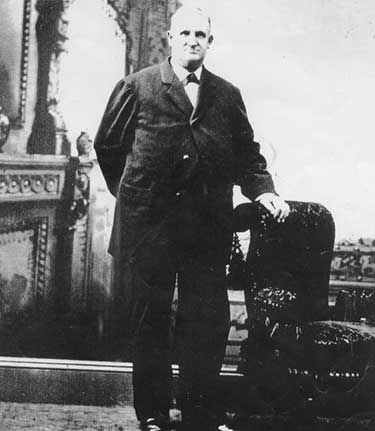Turlock's History

John Mitchell - Founder of Turlock
The great valley of California is divided into the northern portion, the Sacramento Valley, and the southern portion, the San Joaquin Valley. The dividing point is the Delta where river waters join and flow to the sea through the San Francisco Bay. The land that would become Turlock is located in the southern portion of the San Joaquin Valley near the Tuolumne River in Stanislaus County. Those who have studied the valley say that the area was naturally designed for agriculture with snow accumulation to the east in the Sierra Nevada range, a relatively flat valley floor and an abundance of sunshine. In The Seven States of California the author, Philip L. Fradkin, contends that the valley’s natural landscape has been superficially altered by man four times in the last two hundred years.The first change occurred around 1880 when the natural landscape was changed to a livestock or grazing landscape. In 1865 the grazing landscape was converted to a wheat production landscape. 1900 brought the change from a wheat, dry-farming landscape to an irrigated agricultural landscape. Finally, around 1960, the agricultural landscape began to coexist with the urban landscape.
The Native Americans, the Yokut Indians, are known to have lived in the valley during the natural landscape period. One historian refers to the Yokuts of Stanislaus County as Laquisimas Yokuts who called the Stanislaus River Laquismes. They were associated with tribes or “ocean people” from the coast and their currency or coveted treasures were forms of abalone jewelry or pieces of abalone shell. Some historians contend that the Yokuts, who ate mostly seeds, plants, edible roots and some fish, were driven from the area during the 1850’s when the change to livestock grazing peaked. Other sources indicate that the Yokuts had migrated from the area before the grazing of large herds began.
One settler in the valley, John William Mitchell, participated in both the livestock period and the conversion to the wheat, dry-farming period. Mitchell enjoyed financial success buying land, developing large herds of cattle and sheep and marketing them to the gold country miners. He purchased additional lands, over one hundred thousand acres in total, and became a wheat farming leader, cultivating tracts under the tenant system. During this time, Mitchell observed that transportation dependency was beginning to shift from the river to the rail. He had the vision to match his land purchases to the speculated route of the Southern Pacific expansion to the south.
John Mitchell granted the right of way to the Southern Pacific and negotiated for a depot in what would become Turlock. This transportation link for freight and passengers was the catalyst that brought business proprietors and settlers to the area and changed the 1850’s settlement into an organized town. John Mitchell, founder of Turlock, and his wife had no children but some of his siblings and their descendants did follow him to this new town. Many Turlock residents today find their roots in the extended family tree of John Mitchell.
While the depot was being constructed, Mitchell built a grain warehouse and businessmen moved buildings to town or built new ones to provide goods and services to farmers and anyone getting on or off the train. The railroad, with its depot, was one
important factor that brought Turlock alive and kept it growing and changing through the end of the 19th century.
At the turn of the 20th century the Turlock Irrigation District, the first California district under the Wright Act of 1887, brought irrigation water to the valley. As the irrigation system was being developed, wheat production was declining. Heavy grain production was exhausting the once-fertile soil and new crops with irrigation could renewed success. The Turlock Irrigation District was the second important factor that has kept Turlock thriving; growing and changing through the end of the 20th century.
Around 1893, the landholdings of the deceased John Mitchell were being subdivided into 20-40 acre tracts. A large influx of new settlers from the mid-west arrived in Turlock in 1903 and 1904 because of the milder climate, cheap land prices and the promise of abundant irrigation water. A dam and system of canals provided the needed resource for crop diversification and the development of agricultural industry that changed the small town into a successful city.